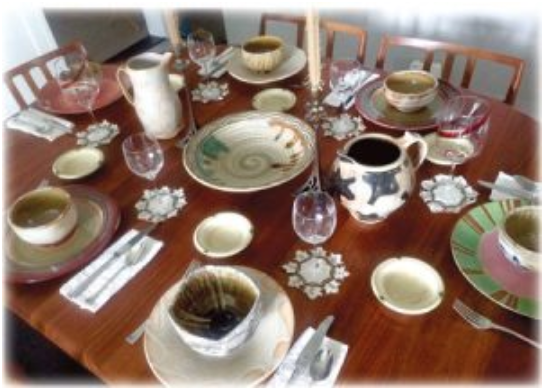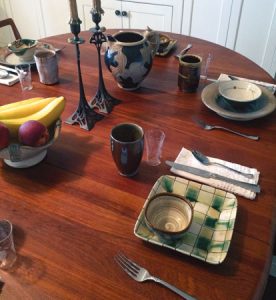I’m going to admit something here. Although I have been both a potter and gallery owner representing dozens of studio ceramists for 20 years, I don’t own matching dinnerware.
I always believed that I should, and would do so when the perfect set presented itself, but it never happened. With the exception of my grandmother’s set of formal china, that hasn’t seen the light of day in 15 years, none of my dishes match—not plates, not cups, not bowls. It’s not like the  opportunities haven’t been there—my professional life is spent making and sourcing the best pottery possible for my customers, visiting ceramics studios around the world, and buying directly from artists and artisans. Studio ceramics is the lens through which I see the world, but still, there’s no dinnerware set. Instead, what I have amassed is a fairly remarkable collection of one-offs, and the occasional pair, of ceramics. Here’s a delightful little secret: It’s much better this way. I get such pleasure out of using a variety of pieces. My table looks much more interesting and engaging than the traditional, uniform setting. Not only can each individual piece be treasured, there is also so much flexibility in table-setting.
opportunities haven’t been there—my professional life is spent making and sourcing the best pottery possible for my customers, visiting ceramics studios around the world, and buying directly from artists and artisans. Studio ceramics is the lens through which I see the world, but still, there’s no dinnerware set. Instead, what I have amassed is a fairly remarkable collection of one-offs, and the occasional pair, of ceramics. Here’s a delightful little secret: It’s much better this way. I get such pleasure out of using a variety of pieces. My table looks much more interesting and engaging than the traditional, uniform setting. Not only can each individual piece be treasured, there is also so much flexibility in table-setting.
I’d like to share some ideas about bringing handmade studio ceramics to the table in a fun, thoughtful, rewarding, and personal way; an approach that has little to do with formality or any preconceived notions about how tableware should function, and has everything to do with enriching the experience of dining.
First, a little warm fuzziness for craft and its ways: I realized a long time ago that fine craft (pots, in particular) functioned for me the way photographs do for other people. Handmade pieces can evoke a mood, memory, emotion, or all the above. Americans are increasingly enjoying the embrace of craft and craftsmanship. Its popularity is particularly of note within the progressive food culture. There are craft beers, artisanal cheeses, and small-batch just-about-everything. One important way we are addressing the looming challenges of consumption and sustainability within our environment and economy is by placing more value on quality, skill, creativity, and careful use of resources—all basic tenets of craft. The Slow Food movement, the prevalence of farmers’ markets, and the demand for organic produce reflect this necessary and forward-thinking shift. My real hope is that our economic and obesity crises have prompted us to re-evaluate the way in which we do a lot of things. As what we eat evolves to meet the needs of a changing world, our choices about how we serve food can better reflect and support those changes. We can do better with less.
The list of the benefits of craft is impressively long. We not only get economic, environmental, and health benefits, but also intellectual, spiritual/emotional, sensory, and functional ones. There are many aspects to nourishment. The Japanese tea ceremony is one example. The ritual exists as a highly sophisticated cultural and social event. Objects for the ceremony are selected very carefully, and the ceramics are particularly prized. Not strictly for function, the combination of objects chosen by the master creates an environment that sets a mood, conveys a theme, and ideally crafts a rich, meaningful experience for the participant. Oh, it’s good stuff. The path to the tea hut, selection of artworks, and highly choreographed movements are deliberate and set the stage for what is to come. This inspires me to think more carefully and creatively about serving food and drink. Good ceramics can elevate even the simplest foods. A few slices of fruit or a cup of tea become full sensory experiences mixed with art, history, and the touch of the hand.
When talking with clients about starting their collections, I advise them to take their time, enjoy the process, and expect not to make a purchase every time they visit the shop. Potters spend an inordinate amount of time making and refining their work, and customers should delight in discovering those elements for themselves. We eat first with our eyes, but that’s just the beginning. Dining from a hand-made, fully-considered piece encourages a slower pace and allows us to be more present and connected (as well as to enjoy the enhanced flavors and textures that come from cooking in ceramics).
A kitchen can only hold so much dinnerware, so be discerning! There’s no need to worry about sets or matching patterns. When you really trust yourself to buy only pieces that speak to you, your personalstyle becomes the cohesive element needed to make those pieces work together, and developing a collection is a good bit of fun. Dynamic table settings and interesting combinations start to occur, and the holes of what’s needed quickly reveal themselves. Ultimately, larger pieces are important, but they shouldn’t be on your starter list until you get the big heart-tug.
One of the great benefits of handmade ceramics is their versatility. If you choose wisely, you can get a variety of uses out of each individual piece. Good quality pots can go from cooking to serving toindividual plating and will be with you for a very long time. Here are some places to start:
Tea bowls, for their versatility and wide availability in the world of contemporary studio ceramics, these handle-less cups are very high on my list. There are many kinds of tea bowls—formal and informal—many shapes and sizes. A light colored interior allows the tea’s subtle color variations, particularly green and white teas, to be seen. An upright form will retain the heat during the winter, and a lower and more open shape will allow the heat to dissipate in the summer. Before committing to a tea bowl, hold it in your hand. The fit is personal. Folks sometimes express concern about heattransfer to the hand, but a tea bowl frequently is made with a kodai or foot that will keep the fingertips away from the actual heat. A Japanese-inspired tea bowl can be repurposed for coffee, juice, smoothies, ice cream, and for plating individual desserts or serving accompaniments such as lemons, sour cream and the like.
An oval or oblong serving piece is a great way to utilize limited real estate at a table. Oblong pieces create more options and allow for better presentation of food with strong visual impact—sushi, Caprese salad, whole fish, vegetables, charcuterie, and baked goods. I always recommend choosing something with a little bit of depth so that it can be used for baking as well. Tarts, gratins, quiches, and bar desserts. See what I’m doing here? One piece, multiple uses.
“Plowls” are a bit of an in-house joke at the shop. Years ago, a friend requested a flat plate with sides deep enough so he wouldn’t spill as he ate at his couch. As it turns out, this shape is incredibly useful. A happy cross between plate and bowl, “plowls” are probably the most used pieces in my kitchen. They are great as breakfast or lunch plates—for salads, pasta with sauce, protein and veggies, eggs, and sandwiches. We have stacks of them in all different sizes that we put out for a buffet or barbecue. Guests love selecting the piece they want to use.

Studio ceramics are the lens through which I see the world.
Uprights (bowls, vases, pitchers) I love taller shapes at the table. They add dimension and texture to the table-scape. Uprights bring food off the horizontal plane, giving you much more room at the table (and who doesn’t need that at a dinner party?). Think chopped salads, side dishes, salsas, sauces, bread, or celery sticks, and even soups. Uprights offer dual duty as they’re great for flower arranging, too.
Smalls: Ooh, I love teeny pieces and actually choose to serve food that allows me to use lots of them. An arrangement of breads and crackers interspersed with small bowls of accompaniments is so nice to look at. I only put out a little of each food item—chèvre, roasted red peppers, olives, tapenades, infused oils, jams, pâté, or confit and refill the faves and cut down on waste.
Plates buy them in pairs. You can make interesting patterns when you set the table, and breaking one doesn’t mean the end of the whole set. Plus you can make the 18-20 person service obsolete.
Shallow bowls bake quiche, pie, potatoes, serve salads and pasta, store fruits or vegetables. If you have recipes you make regularly, think of the shallow bowl as the food’s frame or presentation element.
Come on, let’s break some rules. Vary sizes, shapes, colors, texture when choosing tea bowls, plowls, oblongs, uprights, smalls, and plates. Be discerning. Trust yourself to buy only pieces that speak to you, and your personal style will make all the pieces work together.
Memories of my travels—the folks who have made pieces in my collection, their care and insights—are always with me at my table. It is deeply satisfying. There’s no wrong way to build your collection. Start slowly; learn what you like best, and then buy what you need. Soon, you’ll have an eclectic dinnerware collection to treasure and build upon for years to come.
Lisa Howard is the owner and chief executive potter at Local Pottery in Norwell, Massachusetts. She believes that handmade things enhance our lives in many ways.
Related post: The Dish Ran Away with the Spoon by Peter Follansbee.
In our household, getting out the good tableware often means getting out woodenware. I have been a woodworker for over 35 years now, and making spoons has been part of my work since the early 1980s. I learned how to make furniture from “green” wood; splitting the pieces from a tree shaping them into furniture parts. This meant no trip to the lumber yard for me, but lots of time searching through wood piles, log yards, and the woods. That’s where the spoons are…





